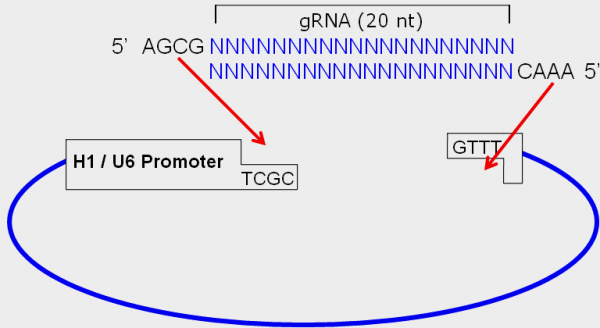CRISPR gRNA lentivectors
About CRISPR gene editing:
The CRISPR (Clustered Regularly Interspaced Short Palindromic Repeats) technology is a targeted and precise genomic gene-editing method. A target sequence-specific guide RNA molecule (gRNA) directs a Cas endonuclease to the genomic DNA target sequence. Then, the Cas enzyme creates a double-strand break (or single cut depends on Cas enzyme types) at the target sequence that can be repaired either by Non-Homologous End-Joining (NHEJ), which can result in insertion or deletions (InDels), or by Homology Directed Repair (HDR) when a repair Donor DNA template is present. InDels can disrupt the expression of the target gene (So-called, Knock-Out). While repaired by HDR, the genome was modified with a foreign gene (So-called, Knock-In), or corrected of the target gene (targeted gene therapy).
CRISPR gRNA lentivector cloning kits:
CRISPR/Cas9 technology requires minimal two components:
1) Cas9 endonuclease: Gentarget provides a set of standalone Cas9 expression lentivirus with different selection markers. One Cas9 expression lentivirus can be used together with multiple gRNAs to perform genomic sequence editing.
2) Target-specific guild RNA (gRNA): Gentarget provides a set of gRNA lentivector cloning kits for users to construct the desired target specific gRNA lentivector. The gRNA is transcribed under either the human U6 promoter or the human H1 promoter with different selection markers. The modified H1 promoter is an optional inducible promoter, which can be used for tetracycline-induced expression when needed. see gRNA lentivector’s cloning schemes below:


Key features of gRNA lentivector cloning kit:
- Pre-linearized lentivector–no need for tedious work at the preparation of lentivector backbone,
- Precisely directional cloning of your DNA duplex encoded gRNA structure,
- Rapid, highly efficient cloning with low background. Clones has >95% positive.
- Internal fluorescent reference (for some gRNA lentivectors): the vector encodes a fluorescent protein (GFP or RFP), allowing real-time monitoring of transfection or virus transduction efficiency.
- Flexible antibiotic selection: the lentivector encodes an antibiotic marker or a dual marker (a fluorescent-antibiotic fusion marker) allowing to select the transduced cells, via the desired antibiotic selection, Neomycin, Puromycin, Blasticidin, Zeocin,
- Optional inducible knockdown (only for H1 promoter): The gRNA lentivectors driven by the optional inducible H1 promoter can be used for constitutive high expression without the need for induction. Optionally, this modified H1 promoter allows the inducible expression of gRNA when the tetracycline repressor protein (TetR) in present in advance (see inducible expression link for its mechanism).
See Product Manual for details